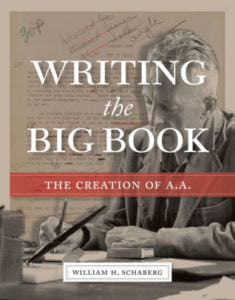Resource Library
The Creation of AA and its Iconic Text
 Considerable research has been done on the birth and early evolution of A.A. since Not-God: A History of Alcoholics Anonymous by Harvard-trained historian Ernie Kurtz was published in 1979. Ernie was subsequently encouraged and enthralled by each new historical discovery about A.A. but remained in the final years of his life disappointed that no one had since published a scholarly update of A.A.’s birth and continued evolution. If Ernie was still with us, he would be the first to congratulate William H. Schaberg on the publication of Writing the Big Book: The Creation of A.A.
Considerable research has been done on the birth and early evolution of A.A. since Not-God: A History of Alcoholics Anonymous by Harvard-trained historian Ernie Kurtz was published in 1979. Ernie was subsequently encouraged and enthralled by each new historical discovery about A.A. but remained in the final years of his life disappointed that no one had since published a scholarly update of A.A.’s birth and continued evolution. If Ernie was still with us, he would be the first to congratulate William H. Schaberg on the publication of Writing the Big Book: The Creation of A.A.
Recent decades have witnessed growing interest in the history of Alcoholics Anonymous, with both professionals and amateurs (e.g., members of AA History Lovers) making important discoveries. Numerous biographical works on early A.A. figures include Bill Wilson, Lois Wilson, Dr. Bob, Anne Smith, Dr. William Silkworth, Clarence Snyder, Marty Mann, Sister Ignatia, Nell Wing, and Fr. Ed Dowling. Equally important works on the history and experience of particular groups within A.A. have been published, most notably Glen C.’s Heroes of Early Black AA, Jolene Sanders’ Women in Alcoholics Anonymous, Roger C.’s A History of Agnostics in AA, and Audrey Borden’s The History of Gay People in Alcoholics Anonymous. But until publication of Writing the Big Book, there has been no scholarly history of early AA with the academic rigor or quality of storytelling found in Not-God.
Comparisons between Writing the Big Book and Not-God are apt as Schaberg follows the major admonitions Ernie Kurtz shared with so many of us about how to do exemplary historical research and writing. Schaberg tells the story of early AA chronologically so that we as readers retain a clear sense of sequence and how each event flowed from what preceded it and influenced what followed, and he identifies crucial events and decisions that defy such orderly sequence. He tells the story in context so that we as readers understand the cultural and organizational atmosphere in which key decisions were made. Like Kurtz, Schaberg provides us with all the evidentiary sources that help separate fact from widely-promulgated myths about A.A.’s birth and early evolution. His liberal use of excerpts from primary sources is crucial as many of the contemporary documents challenge popular origin myths about A.A. Schaberg tells the A.A. story from multiple personal and localized (e.g., Akron, New York, and Cleveland) perspectives, clearly identifying what we know and the mysteries that remain pending the discovery of new evidence. Finally, Schaberg defies the “history is boring” trope by detailing a most fascinating story that keeps the reader—even the informed reader—wanting to keep turning pages to find out what happens next. There are some surprises in these pages!
The early history of A.A. as first outlined in 1979 in Not-God has now been skillfully and eloquently updated. What remains is a new scholarly history that documents the ongoing evolution of A.A. over the last five decades—a history every bit as complex and engaging as A.A.’s birth and early years, but a story that remains untold. Researching more recent decades and A.A.’s history as it is now unfolding is as great a challenge as that faced by Kurtz and Shaberg. Perhaps someone reading Writing the Big Book will have the commitment, skill, and persistence to research and share this still-unfolding story. I hope so, as the future of A.A. may well rest with understanding these later years of A.A. William H. Schaberg has performed a great service by placing Writing the Big Book—The Creation of A.A. in our hands. The remaining question is how A.A. has adapted and evolved since its founding decades. It will be up to future historians to reveal the continuing history of A.A. and the larger history of addiction recovery.
Writing of the Big Book: The Creation of A.A. will be released on November 5, 2019.
